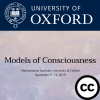Peter Grindrod - Large scale simulations of information processing within the human cortex: what “inner life” occurs?
Peter Grindrod (joint research with Christopher Lester)
Mathematical Institute, University of Oxford
We seek to model the human cortex with 1B to 10B neurones arranged in a directed and highly modular network (a network of networks); with the tightly coupled modules (each containing 10,000 neurones or so) representing the cortical “columns”. Each neurone has an excitable and refectory dynamic and the neurone-to-neurone connections incur individual time delays. Thus the whole is a massive set of modular delay-differential equations (expensive to solve on a binary computer, but easily implemented within 1.5kg of neural wet- ware). Our early work has shown why evolution has resulted in such a design to ensure optimal use of the limited space and energy available. Indeed we can show that if the time delays were all integers rather than reals then much of the potential behaviour (dynamical degrees of freedom) would be lost.
Simulating a 1B neurone directed graph produces its own big data challenge. We focus on the inner life of these complex dynamical system, and show that the dynamical responses to external stimuli result in distinct, latent (internal), dynamic “states" or modes. These inner subjective and private states govern the immediate dynamical responses to further incoming stimuli. Hence they are candidates for internal “feelings”. So, what is it like to be a human? A human brain must also possess such inertial dynamical states, and a human brain can experience being within them: they are natural and necessary byproducts of the system's architecture and dynamics, and they suggest that the "hard problem of consciousness” is mainly explicable, and can be anticipated, in terms of network science and dynamical systems theory.
The numerical simulation at such large scales requires a special computing platform, such as SpiNNaker (at the University of Manchester). We will set out
the methodology to be deployed in (i) defining such complex systems; (ii) in simulating the spiking behaviour being passed around when such a system is subject to various stimuli; and (iii) the post processing - reverse engineering - of the whole system performance, to demonstrate that internal states/modes exist. We cannot reverse engineer a real human brain at the neurone-to- neurone level, but we can do so for such ambitious simulations.
Filmed at the Models of Consciousness conference, University of Oxford, September 2019.




